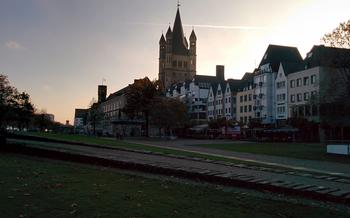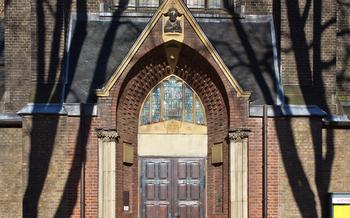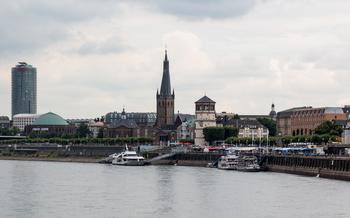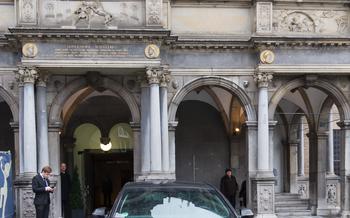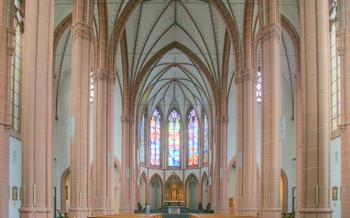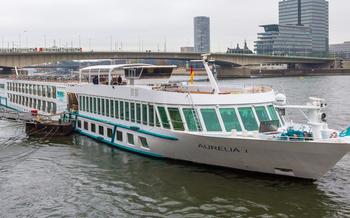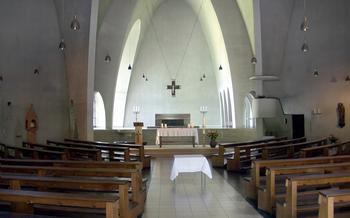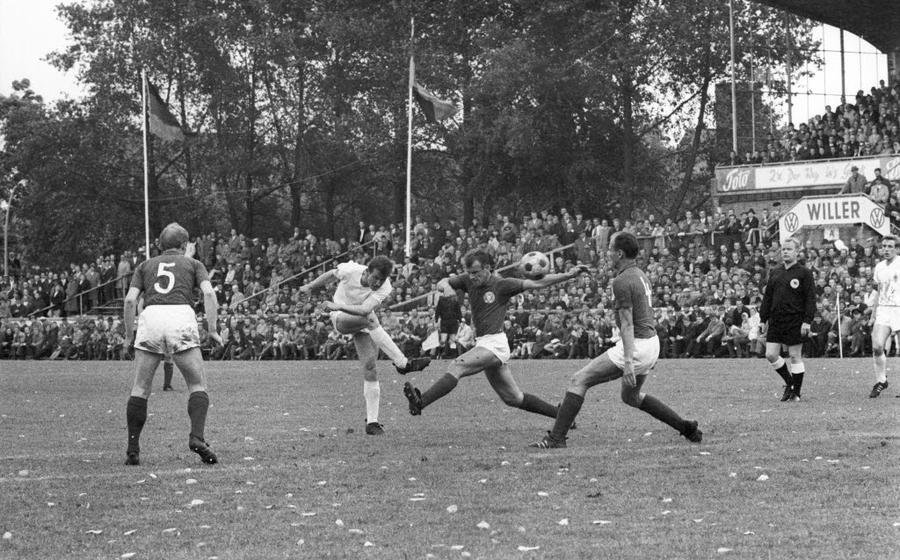
Ständerhaus
- Mönchengladbach: A City with History
- Events and Exhibitions
- Surrounding Attractions
- Shopping and Dining
- Accommodation Options
- Transportation and Accessibility
- Planning Your Visit
- Cultural Significance
- Architectural Details
- Historical Context
- Contemporary Use
- Insider Tip:
Mönchengladbach: A City with History
Mönchengladbach, a city steeped in history, traces its roots back to the Middle Ages. Once a thriving center of textile production, the city's rich heritage is evident in its historical landmarks and monuments. From the imposing walls of the Old Town to the grand structures that line the streets, Mönchengladbach breathes history with every step.
The textile industry played a pivotal role in shaping the city's identity. In the 19th century, Mönchengladbach emerged as a textile powerhouse, earning it the title of "German Manchester." The city's factories and mills churned out high-quality textiles, contributing significantly to its economic prosperity. This legacy is still visible today, with many former textile mills converted into cultural centers and creative spaces.
Mönchengladbach's historical significance extends beyond its textile industry. The city has witnessed pivotal events and transformations throughout the centuries. From its humble beginnings as a small settlement to its rise as a major industrial hub, Mönchengladbach has played a crucial role in the development of modern-day Germany. Its rich history, preserved and celebrated by its citizens, continues to shape the city's identity and allure.
Events and Exhibitions
The Ständerhaus is not just a historical monument but also a vibrant cultural hub that hosts a variety of events and exhibitions throughout the year. These events offer visitors an opportunity to delve deeper into the history and culture of Mönchengladbach and experience the building's unique atmosphere.
Regular art exhibitions showcase the works of local and international artists, providing a platform for creative expression and allowing visitors to appreciate the diverse artistic talents of the region. Historical reenactments and cultural performances bring the city's heritage to life, offering a glimpse into the traditions and customs of past generations.
Special events and festivals are organized throughout the year to celebrate Mönchengladbach's unique traditions and create a sense of community among locals and visitors alike. These events often feature live music, traditional dancing, food stalls, and family-friendly activities, providing an opportunity to immerse oneself in the city's vibrant cultural scene.
Whether you're an art enthusiast, a history buff, or simply looking for a fun and engaging experience, the Ständerhaus offers a diverse range of events and exhibitions that cater to all interests. Be sure to check the building's website or contact the tourist information center for the latest event listings and schedules to make the most of your visit.
Surrounding Attractions
In the immediate vicinity of the Ständerhaus, visitors can discover a wealth of other notable landmarks and attractions that further enrich their understanding of Mönchengladbach's rich history and cultural heritage. The Abteiberg Museum, a short stroll from the Ständerhaus, houses an impressive collection of modern and contemporary art, showcasing the city's vibrant artistic scene. Its striking architecture, perched atop a hill overlooking the city, makes it an architectural gem in its own right.
Rheydt Castle, another must-see destination, lies just a few kilometers from the city center. Steeped in history, this magnificent castle boasts a beautifully preserved exterior, surrounded by lush gardens that invite visitors to explore and unwind. Its interior houses a museum that delves into the fascinating history of the castle and the surrounding region, offering a glimpse into the lives of its former inhabitants.
For those seeking a tranquil escape amidst nature's embrace, the Botanical Garden, situated a short distance from the Ständerhaus, provides a serene oasis. With its meticulously landscaped grounds and diverse collection of plant species from around the world, the garden offers a peaceful retreat for nature enthusiasts and a delightful respite from the bustling city.
Shopping and Dining
In the delightful vicinity of the Ständerhaus, visitors can embark on a culinary and shopping adventure. A plethora of shops, boutiques, and restaurants awaits, offering an array of delectable cuisine and unique souvenirs.
Indulge in traditional German delicacies at one of the many restaurants, where hearty dishes such as schnitzel and bratwurst are lovingly prepared and served with warmth and hospitality. For those seeking a taste of international flavors, there are establishments offering a diverse range of cuisines from around the world.
Local markets and specialty shops are a treasure trove of unique souvenirs and handmade crafts. Browse through an array of local products, from traditional pottery and glassware to handcrafted textiles and artisanal chocolates. These markets offer a glimpse into the local culture and provide an opportunity to support the talented artisans of Mönchengladbach.
For a relaxing break, savor a cup of freshly brewed coffee or indulge in a sweet treat at one of the charming cafés or bakeries in the area. These cozy establishments offer a respite from sightseeing, allowing visitors to unwind and soak in the city's ambiance.
Accommodation Options
The proximity of the Ständerhaus to the city center offers a wide range of accommodation options for visitors to Mönchengladbach. From budget-friendly guesthouses to luxurious hotels, there is something to suit every traveler's needs and preferences.
For those seeking a comfortable and affordable stay, the Jugendherberge Mönchengladbach is an excellent choice. Located just a short walk from the Ständerhaus, this modern hostel offers dormitory-style rooms as well as private rooms, making it ideal for backpackers and budget travelers.
For a more luxurious experience, the Hotel am Park is a 4-star hotel situated opposite the Abteiberg Museum, a short stroll from the Ständerhaus. This elegant hotel offers spacious rooms with stunning views of the park, as well as a range of amenities including a spa, a fitness center, and a fine-dining restaurant.
For those seeking a unique and charming accommodation, the Hotel Schloss Rheydt is a historic castle hotel located in the Rheydt district, a short bus ride from the Ständerhaus. This beautifully restored castle offers elegant rooms and suites, as well as a range of amenities including a restaurant, a bar, and a wellness area.
No matter your budget or preferences, you're sure to find the perfect accommodation in Mönchengladbach to make your visit to the Ständerhaus and the city a memorable one.
Transportation and Accessibility
Getting to the Ständerhaus is a breeze, thanks to Mönchengladbach's efficient public transportation system. Several bus and tram lines stop right outside the building, connecting it to all corners of the city. For those who prefer to explore at their own pace, bicycle rental services are available nearby. If you're driving, there are plenty of parking options within walking distance. Whether you choose to walk, cycle, or drive, the Ständerhaus is easily accessible and ready to welcome you.
Planning Your Visit
When planning your visit to the Ständerhaus and Mönchengladbach, consider the following recommendations:
-
Explore at Your Pace: Allocate at least two to three hours to thoroughly explore the Ständerhaus and its exhibits. Allow additional time if you plan to visit nearby attractions or participate in guided tours.
-
Day Trip or Extended Stay: For a comprehensive experience, consider spending a day or two in Mönchengladbach to fully immerse yourself in the city's history and culture. This allows you to explore the Ständerhaus, visit other landmarks, and savor the local atmosphere.
-
Avoid Crowds: If possible, plan your visit during the off-peak season (typically autumn and winter) to avoid large crowds and ensure a more personalized experience.
-
Advance Booking: Certain events and exhibitions at the Ständerhaus may require advance booking, especially during peak tourist season. Check the official website or contact the information center for details.
Cultural Significance
The Ständerhaus holds immense cultural significance as a symbol of Mönchengladbach's identity. It represents the city's rich history, traditions, and heritage. The building has played a crucial role in preserving and promoting local customs, folklore, and festivals. It serves as a venue for cultural events, exhibitions, and performances that showcase the city's vibrant art scene and diverse cultural heritage. The Ständerhaus stands as a testament to the enduring spirit of Mönchengladbach and its commitment to celebrating and nurturing its cultural roots. Moreover, the building's architectural grandeur and historical significance contribute to the city's overall cultural landscape, attracting visitors from near and far to experience its unique charm and allure.
Architectural Details
The Ständerhaus stands out from other buildings in Mönchengladbach due to its unique architectural features. Constructed in the 16th century, the building showcases a harmonious blend of Gothic and Renaissance styles. The Gothic influence is evident in the pointed arches, ribbed vaults, and intricate tracery windows. In contrast, the Renaissance style is reflected in the symmetrical facade, pilasters, and classical pediments.
The exterior of the Ständerhaus is adorned with exquisite carvings and sculptures that depict biblical scenes, mythological figures, and historical events. These intricate details add depth and character to the building, providing a glimpse into the artistic and cultural influences of the time. The blend of architectural styles and decorative elements creates a visually stunning masterpiece that captivates visitors from all over the world.
The historical significance of the Ständerhaus's construction and restoration further enhances its architectural value. The building has undergone several renovations and expansions throughout the centuries, each of which has left its mark on the structure. These modifications showcase the evolution of architectural styles and techniques over time, making the Ständerhaus a living testament to Mönchengladbach's rich history and cultural heritage.
Historical Context
The construction of the Ständerhaus can be traced back to the 16th century, a period of significant political and social transformation in Mönchengladbach. The city, which had long been under the rule of the Archbishops of Cologne, was granted imperial immediacy in 1540, making it a free imperial city. This newfound independence brought with it a desire for self-governance and the establishment of a central administrative building.
The Ständerhaus was erected as a symbol of this newfound autonomy. It was designed to house the city council and provide a meeting place for the representatives of the various guilds and trade associations. The building's prominent location in the heart of the city reflected its importance as a center of civic power and decision-making.
Over the centuries, the Ständerhaus witnessed many significant events in Mönchengladbach's history. It was the site of important political debates, diplomatic negotiations, and celebrations. The building also served as a refuge for the city's residents during times of war and turmoil.
During the Thirty Years' War, which ravaged much of Europe in the 17th century, the Ständerhaus was damaged by fire and looting. However, it was later restored and continued to serve as the city's administrative center.
In the 19th century, Mönchengladbach underwent rapid industrialization, driven by the growth of the textile industry. The Ständerhaus became a symbol of the city's economic prosperity and was expanded to accommodate the growing number of city officials and administrators.
The building survived the Allied bombing raids of World War II relatively unscathed and continued to be used for its original purpose after the war. In the 1970s, the Ständerhaus underwent a major renovation and restoration, which returned it to its former glory and preserved its historical significance for future generations.
Contemporary Use
Today, the Ständerhaus serves as a vibrant community center and cultural hub in Mönchengladbach. It hosts a diverse range of exhibitions, events, and cultural programs throughout the year. These include art exhibitions showcasing local and international talent, historical reenactments and performances that bring the city's heritage to life, and special events and festivals that celebrate Mönchengladbach's unique traditions.
The Ständerhaus is also a popular venue for conferences, workshops, and seminars, providing a historic and inspiring setting for gatherings of all kinds. Its spacious rooms and modern facilities can accommodate groups of various sizes, making it a versatile choice for both professional and social events.
Furthermore, the Ständerhaus is home to the city archives and research facilities, which are open to the public. History enthusiasts can delve into the rich past of Mönchengladbach by exploring the vast collection of documents, manuscripts, and photographs housed within the archives. Guided tours and workshops are also offered, providing visitors with a deeper understanding of the city's history and cultural heritage.
Through these initiatives, the Ständerhaus plays a vital role in preserving and promoting Mönchengladbach's cultural identity, fostering a sense of community, and contributing to the city's vibrant cultural and social landscape.
Insider Tip:
As you explore the Ständerhaus and its surroundings, be sure to seek out the hidden courtyard, tucked away behind the building. This tranquil oasis offers a serene escape from the bustling city streets. Admire the beautifully preserved half-timbered houses that line the courtyard, transporting you back in time to Mönchengladbach's rich past. Take a moment to relax on one of the benches, soak in the peaceful atmosphere, and let the history of this remarkable place wash over you.
For a unique culinary experience, venture to the nearby "Zum alten Brauhaus" restaurant, just a short walk from the Ständerhaus. This traditional German eatery serves up authentic local dishes in a cozy and inviting atmosphere. Indulge in hearty specialties like "Rheinischer Sauerbraten" (marinated beef roast) or "Mönchengladbacher Reibekuchen" (potato pancakes) paired with a refreshing Kölsch beer. The friendly staff and warm ambiance will make your dining experience truly memorable.
To capture the essence of the Ständerhaus and its surroundings, head to the observation tower for breathtaking panoramic views of Mönchengladbach. Ascend the winding staircase to the top and be rewarded with a stunning vista that encompasses the city's historic landmarks, lush parks, and the meandering Rhine River in the distance. Don't forget your camera to immortalize this unforgettable moment.
